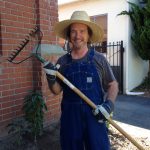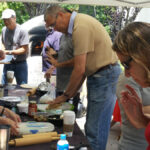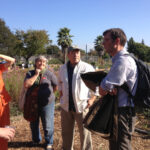Church as welcoming community
In losing a dear friend, Peter Rood (read more here), my mind goes many squirrely places. This past week, I’ve been reflecting on our 12+ years of working/volunteering together, as well as our ongoing friendship after he moved to Washington. In my grief, I ramble, and for that I apologize up front. But there are some things I’ve never written about our story.
The working/volunteering partnership between Peter & I was based on some mutual understandings about community, about people and ecosystems, about the role a church organization could play in the massive transition humanity is navigating, and the diverse and beautiful “ecology” that is human spirituality.
Peter, with his typical humor, came up with the descriptor “front-door-on-Sunday people.” By contrast, I was (proudly) not a front-door-on-Sunday person. I would laugh and describe myself as a “side-garden-on-Thursdays person.” Truth be told, in service of the Community Garden and Oven and ECM’s various events, I probably “attended” the HN campus more often than many of his front-door-on-Sunday parishioners.
Peter had metrics his organization maintained, statistics on front-door-on-Sunday attendance. He used to joke that a better metric of HN community success would be the number of toilet flushes, because that would show how many people were truly welcomed, 24/7/365 at the site.
ECM was never a “project” of HN’s front-door-on-Sunday people. Yes, there was some overlap — perhaps not as much as Peter hoped — although over time the ideas ECM was exploring did seem to rub off on the official parishioners, and they seemed proud to have all the environmental activities at the site.
For the 11 years I managed the Community Garden, the Garden was maintained by neighbors, mostly non-parishioners. Through the years, several churches — and the Episcopal Diocese of Los Angeles — consulted with Peter & I about how to replicate ECM and its garden at other sites. They usually began their questions by asking “How do you get more volunteerism from the church people?” Again and again Peter & I stressed that wasn’t how we operated.
ECM was a product of church-plus-community. We would joke that Peter did the “church” part and I did the “community” part — but it went far deeper than that. True, the church provided the land, and paid the water bill, and maintained the toilets through all that flushing. But it was the community — the not-church community — that was the vitality.
Peter was a masterful community-builder. He was a phenomenal networker and resourcer. And, he had an incredible gift of making many people feel at ease, feel welcomed.
And part of that welcoming was to welcome diversity. With open arms.
The ECM community members have diverse spiritual beliefs. A few might be Episcopal, but some belong to Christian circles beyond Episcopal. Some are Jewish, Hindu, Muslim, Buddhist, Wiccan. Some are secular. Some are “spiritual but not religious.” Peter and I cultivated that diverse community with respect. Over time, I helped him to understand that the crucifixes and biblical quotes were at best offputting — more often disrespectful — to this rich and diverse community.
During Peter’s time as pastor, the HN campus began to include the sacred symbols of this diversity. Peter welcomed a Buddha statue to the meditation garden. He placed an Om/Aum symbol in the main garden. We began to celebrate the solstices. The artwork for which HN has become renowned similarly reflected this diversity — the main altar piece has religious images for church services, yet its doors can be closed, transforming it into a more-diverse tree of life. Sadly, the people who have followed Peter in HN’s pastor chair, thus far, have not maintained this welcoming openness.
This week, as I reflected on Peter’s life and great works, I re-read his words in his interview with the Christian Century, as well as the words he wrote in his intro to the book we created together. (you can read them here) True, these two pieces are from “the early years,” but they show the development of his thoughts.
In my opinion, Peter’s ideas transcended “interfaith.” He completely eclipsed that term with the evolution of his thought, in his actions. His ideas accepted that the “one true faith” concept was outdated, was disrespectful of so many people doing great and important work, and was at times the cause for violence.
As ECM explored ideas from peak oil, including Richard Heinberg’s concept of peak everything, Peter and I discussed privately an idea we called “peak church.” This was rooted in the understanding that church attendance in the U.S. had peaked sometime in the 1960s (I don’t know the stats, Peter did), and churches everywhere were struggling. Churches struggled with “meaning” and “relevance.” We spoke together at several church conferences and gatherings, and I heard it all.
But the solution, it seems to me, goes back to Peter’s toilet-flush metric. To church as hosting community. The welcoming arms. It lies in releasing the highly divisive, often colonizing, sometimes violent “one true faith” idea.
Just like Mother Earth is teaching us humans about ecosystems — that all depends upon diversity — the solution to “peak church” goes back to diversity, which in the vernacular is usually called “community.” Monocultures will fall, but diversity is profoundly resilient.


